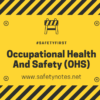
Excavation & Trench Hazard & Control – Toolbox Talk
Hey there! So, today, we’re gonna talk about the dangers you might face when digging and trenching, and how you can keep yourself safe while you’re at it. Excavations and trenches are, no doubt, crucial in the construction industry, whether you’re building something from scratch, laying down pipes, or setting up utilities. But, you gotta admit, they come with a lot of risks if you’re not careful enough. So, let’s dive in and explore some safety procedures that you need to follow to avoid any hazards in This Toolbox Talk.
Excavation & Trenches Hazards
there are some serious hazards associated with excavations and trenches that workers need to be aware of! Let me break them down for you:
- Cave-ins: This is the big one. If the walls of the excavation or trench collapse, workers can get buried alive. Yikes!
- Slip, trip, and fall hazards: Workers can slip or trip and fall into the excavation or trench, or off the equipment used to access them. Watch your step!
- Equipment falling into the excavation area: Heavy equipment used for excavation work can accidentally fall into the excavation area, posing a risk to workers. Look out below!
- Accidents from underground utilities: Workers can accidentally hit underground utilities, such as gas or electrical lines, causing injury or death. Pay attention to where you’re digging!
- Falling objects: Workers can be struck by tools, equipment, or materials that fall into the excavation or trench. Keep your hard hat on!
- Flood and drowning: Water can quickly fill up an excavation or trench, leading to drowning or other water-related injuries. Stay alert during rainy seasons!
- Atmospheric hazards: Excavations and trenches can contain hazardous gases or lack oxygen, leading to suffocation or toxic exposure. Be mindful of the air quality!
- Fire and explosion hazards: If workers are operating equipment that produces sparks or if gas lines are ruptured, a fire or explosion can occur. Better safe than sorry!
How to Controls Hazards
- Double-check that PTW: Make sure to take a gander at the permit-to-work (PTW) and see that everything’s in order for a safe excavation.
- Watch out for hidden hazards: Keep an eye out for any sneaky underground or overhead dangers and either get rid of ’em or let the crew know.
- Pick the right protection: Choose the best protective system for the job, like sloping, benching, or shoring, depending on the situation.
- Give that Risk Assessment a once-over: Give the risk assessment (RA) a good look to make sure all possible risks are under control.
- Easy in, easy out: Make sure the workers have a safe way to get to and from the excavation site, like ladders or stairs.
- Keep traffic in check: If the site’s near a busy road, make sure traffic is controlled so nobody gets hurt.
- Put up those signs and barricades: Let everyone know what’s up with clear signs and barricades around the excavation site.
- Test the air for deep digs: If the hole’s deeper than 1.2 meters, check the atmosphere for any nasty gases and make sure it’s well-ventilated.
- Keep stuff at a safe distance: Keep materials and equipment at least 2 meters from the edge to avoid any accidents.
- Get a competent person’s stamp of approval: Have an expert inspect the site to make sure everything’s hunky-dory.
- Gear up with PPE: Make sure workers are decked out in the right personal protective equipment (PPE) for the job.
- Secure nearby buildings: Check that nearby structures are safe and sound during excavation work.
- Light it up in the dark: Keep the site well-lit during night shifts so workers can see what they’re doing.
conclusion
So, to wrap things up, digging around in excavations and trenches can be quite the risky business, but as long as we stick to the safety rules and keep an eye on those hazards, we’ll all be in shipshape. Don’t forget, if something seems hinky, don’t hold your tongue – let your boss know right away. Cheers for lending me your ears, and remember, safety first, folks!
visit our in-depth article on excavation and confined spaces.



What is the source to come to the conclusion of 1.2meters?–> Test the air for deep digs: If the hole’s deeper than 1.2 meters, check the atmosphere for any nasty gases and make sure it’s well-ventilated.
OSHA 1926.651(g)(1)(i)
Where oxygen deficiency (atmospheres containing less than 19.5 percent oxygen) or a hazardous atmosphere exists or could reasonably be expected to exist, such as in excavations in landfill areas or excavations in areas where hazardous substances are stored nearby, the atmospheres in the excavation shall be tested before employees enter excavations greater than 4 feet (1.22 m) in depth.
SOurce : https://www.osha.gov/laws-regs/regulations/standardnumber/1926/1926.651#:~:text=1926.651(g)(1)(i,1.22%20m)%20in%20depth.